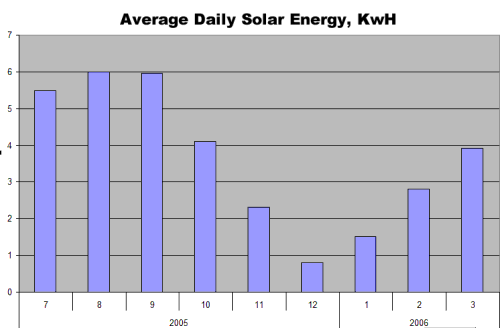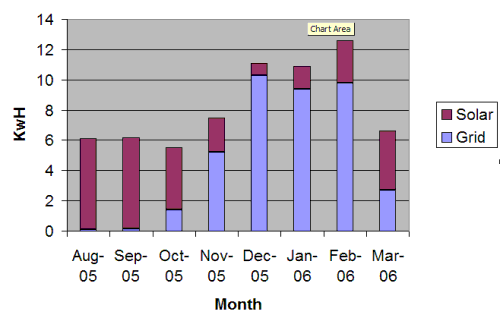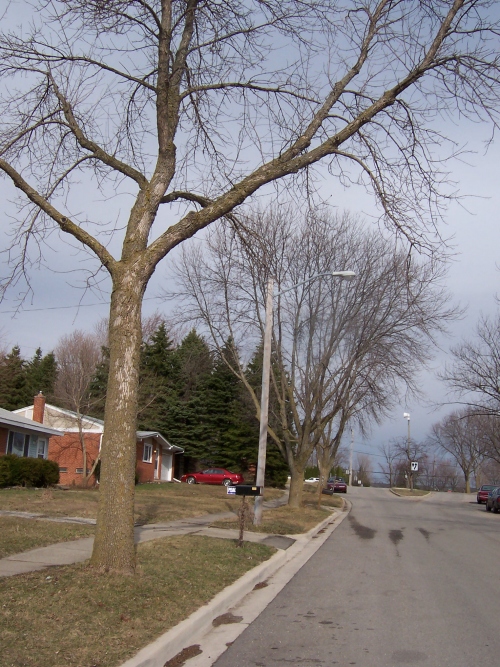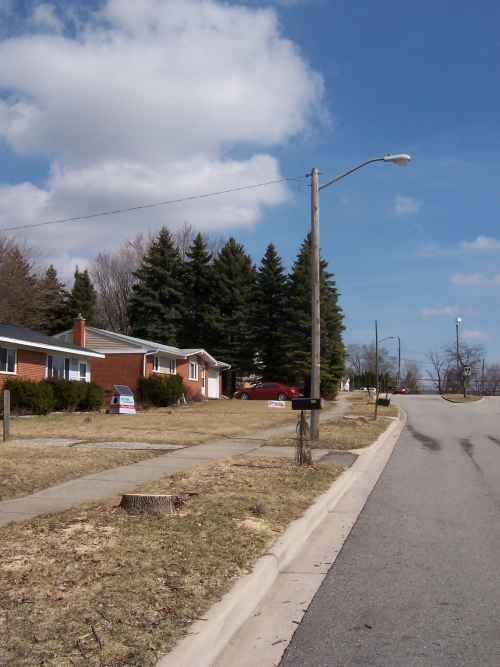Sunday, March 12, 2006
Late winter update
It has been a very warm and sunny winter here in Michigan. Whether it's just a statistical outlier or the onset of global warming, I don't know. But aside from the month between Thanksgiving and Christmas, there hasn't been very much cold weather, and even less snow. February and early March have been spectacularly sunny, and my solar numbers reflect that.
Here's a chart showing the average daily kilowatt-hours generated by my roof, by month.

Several things to note:

And in the lemonade-out-of-lemons category: Last year, there were only three trees which could cast shadows on my solar shingles. This would only happen in the early morning or the dead of winter, but still they were cutting into my solar power. For better or worse (actually both), all three trees were emerald ashes, and had been infected by the emerald ash borer. As you can see from this picture from April 2005, the trees were already dead:

As a safety measure, the city came through the neighborhood in December and cut down all the ash trees. So now, it's all sun, all the time.

And yes, that second photo was taken today, March 12, 2006, technically still winter in Michigan. I was wearing shorts and a T-shirt when I took it. Sixty-three degrees! (It feels warmer than that.)
Here's a chart showing the average daily kilowatt-hours generated by my roof, by month.

Several things to note:
- The July and early August numbers were hampered bad batteries. My first set of batteries was unable to hold a charge, so the solar power had to be used as it was produced--additional sunshine was wasted (and not recorded by the charge controller).
- I do not have a "dump load" connected, and haven't since the system started operating. This means that once the batteries are fully charged and the sun is still shining, no more solar power is produced (basically, the charge controller opens the switch on the wires from the roof to protect the batteries from overcharging). Net metering should solve this problem.
- I have been experimenting with the HBX mode settings on the inverter. HBX allows the system to automatically switch to grid power when the batteries get low, and then back to solar once the batteries have recovered. The Outback inverter lets me define "low" and "recovered" in terms of voltages. If I set these too low, the batteries will discharge too much, shortening their lifespans. If I set them too high, the batteries charge too quickly and the additional solar power available goes to waste (as above). I adjusted the settings higher back in December, hoping to protect the batteries by keeping them in a nearly fully-charged condition most of the time. This also provides me with plenty of backup power in case of a blackout. In February, however, I was caught by surprise by the string of sunny days, and on many of those days I lost quick a bit of potential solar power. I have now lowered the voltage settings to close to where I had them in the summer. Again, net metering should resolve this concern. I'll be able to maintain the batteries at close to full charge most of the time, prolonging their lives and staying prepared for a blackout.
- My 1988-model natural gas furnace was not working well this winter, and got much worse in February. It had a high-wattage fan motor (500-600 watts). In mid-February I replaced it with a new Carrier high-efficiency two-stage furnace. It has a DC fan motor which only uses 80 watts in the low stage (although it runs a higher percentage of the time, so the savings aren't quite that dramatic). In any case, the furnace situation makes it difficult to make much sense out of my energy usage this winter. In December, I had an inefficient old furnace using lots of watts in the cold weather. January was warmer, and I spent the last eleven days in Mexico. When I got back, the furnace was hardly working at all, so I was using electric space heaters a lot (big electricity hogs). Finally, since mid-February I've been enjoying my new furnace. It should save substantially on both electricity and gas use compared to previous winters.

And in the lemonade-out-of-lemons category: Last year, there were only three trees which could cast shadows on my solar shingles. This would only happen in the early morning or the dead of winter, but still they were cutting into my solar power. For better or worse (actually both), all three trees were emerald ashes, and had been infected by the emerald ash borer. As you can see from this picture from April 2005, the trees were already dead:

As a safety measure, the city came through the neighborhood in December and cut down all the ash trees. So now, it's all sun, all the time.

And yes, that second photo was taken today, March 12, 2006, technically still winter in Michigan. I was wearing shorts and a T-shirt when I took it. Sixty-three degrees! (It feels warmer than that.)